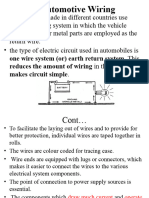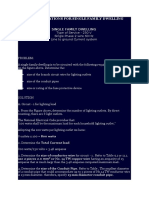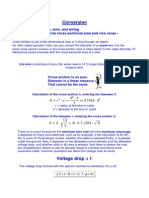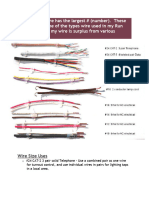Cables & Wires
Cables & Wires
Uploaded by
Sry SantosOriginal Description:
Copyright
Available Formats
Share this document
Did you find this document useful?
Is this content inappropriate?
Report this DocumentCopyright:
Available Formats
Cables & Wires
Cables & Wires
Uploaded by
Sry SantosCopyright:
Available Formats
CABLE & WIRE
The most common type of cable used in houses is technically known as NMD 90 (NonMetallic Dry service cable rated at maximum of 90 degrees Celsius). It is usually a
plastic white covered cable. This cable comes with two or more conductors and includes
a ground wire (bare wire). It is commonly known as "Lumex" (or Romex for our
American friends). T cable is the most commonly used. When I say two conductor
Lumex, I really mean one black wire, one white wire and one ground wire. The ground
wire is never included in the cable count. In a three conductor Lumex cable you would
find one black, one red, one white and a ground wire.
How is Wire Sized?
In Canada and the United States there is a standard by which we measure wire. This
standard is the A.W.G. (American Wire Gauge). The most common size of wire that you
will be dealing with is a #14. Wire sizes start at higher numbers such as #24 (small wire)
and as the number decreases in value the wire increases in size. The largest wire you will
likely need is a #3 gauge. This would be for your incoming service.
Here is a chart showing wire/amperage/breaker sizes:
Wire Size
Rating
(Amperage)
Breaker Size
(Amps)
#14
15 A.
15 A.
#12
20 A.
20 A.
#10
30 A.
30 A.
#8
45 A.
40 A.
#6
65 A.
60 A.
#3
105 A.
100 A.
*All sizes are a maximum value and in accordance with the Canadian Electrical Code.
Most Commonly Used Cables and Their Uses:
2-conductor #14:
plugs, switches, lights (70% of your house wiring).
3-conductor #14:
3-way switches, split receptacles, etc.
2-conductor #12:
selected heaters, air compressors, etc. (anything that uses a maximum of 20 amps)
kitchen receptacles circuits (as per the new provisions in the Canadian Electrical
Code)
3-conductor #10:
any device that requires a maximum of 30 amps. Most common application
would be your electric dryer.
3-conductor #8:
maximum of 40 amps. Most common application would be your electric range.
Note: Some electrical jurisdictions require a minimum wire size of #12 A.W.G. and do
not allow the use of #14. Check with your local electrical authority to determine if this
applies to your area.
Types of Wire
Wire can be either solid of stranded. Most wiring you do in your home will be with solid
wire. Solid wire is easier to work with and takes less time to install. You will find
stranded wire in extension cords and any wire gage over a #10.
You might also like
- Building Electrical Systems Design & DraftingDocument103 pagesBuilding Electrical Systems Design & DraftingEisa Ibrahim Eisa93% (75)
- Salary SurveyDocument15 pagesSalary SurveySry SantosNo ratings yet
- Home Electrical WiringDocument51 pagesHome Electrical Wiringsmanmugen100% (5)
- Cropico Guide To Low Resistance MeasurementDocument37 pagesCropico Guide To Low Resistance MeasurementacebouzouadNo ratings yet
- Ctu+rwy ManualDocument68 pagesCtu+rwy ManualSry SantosNo ratings yet
- LetterAuthorizationConfirmation PDFDocument1 pageLetterAuthorizationConfirmation PDFSry Santos100% (1)
- The Complete Guide To WiringDocument52 pagesThe Complete Guide To WiringEhab SaberNo ratings yet
- American Wire GaugeDocument5 pagesAmerican Wire GaugeCunniah DineshNo ratings yet
- Multitester: Computer System ServicingDocument8 pagesMultitester: Computer System ServicingArthur CapawingNo ratings yet
- Wire Types and SizesDocument24 pagesWire Types and SizesWaqas BhuttoNo ratings yet
- Electrical Cable Size Chart Amps UkDocument3 pagesElectrical Cable Size Chart Amps UknyroochillersNo ratings yet
- Boat ElectricsDocument34 pagesBoat ElectricsSquinkle100% (1)
- AWG Gauge CableDocument3 pagesAWG Gauge Cablesugi yantoNo ratings yet
- SampleFireAlarmSystemCalculations PDFDocument11 pagesSampleFireAlarmSystemCalculations PDFjoan_padilla2000No ratings yet
- Electrical BasicsDocument53 pagesElectrical BasicsAlan SonNo ratings yet
- Chapter 3Document39 pagesChapter 3broNo ratings yet
- Cable SizeDocument6 pagesCable Sizedinahydro1No ratings yet
- Market Survey On ElectricalsDocument16 pagesMarket Survey On ElectricalsGurbaksh SinghNo ratings yet
- Auto Electric I Chapter 1,2Document75 pagesAuto Electric I Chapter 1,2Ebenezer Bekele KebedeNo ratings yet
- Wire GaugeDocument10 pagesWire GaugeSwaraj DhumalNo ratings yet
- Low Resistance Measurement Guide PDFDocument34 pagesLow Resistance Measurement Guide PDFbill1022No ratings yet
- American Wire Gauge Conductor Size TableDocument3 pagesAmerican Wire Gauge Conductor Size TablevahrmNo ratings yet
- Revit Mep Electrical CalculationsDocument22 pagesRevit Mep Electrical Calculationspraveenbusa100% (1)
- PDF The Complete Guide To Wiring Home Wiring and Electrical Installation 1St Edition Isaac Martin Ebook Full ChapterDocument53 pagesPDF The Complete Guide To Wiring Home Wiring and Electrical Installation 1St Edition Isaac Martin Ebook Full Chapterdoris.smart423100% (2)
- CC Crimp GuideDocument53 pagesCC Crimp Guidenajeh100% (1)
- Wiring Calculations For Single Family Dwelling UnitDocument11 pagesWiring Calculations For Single Family Dwelling UnitCalvin Chavez IIINo ratings yet
- Wire Types and SizingDocument33 pagesWire Types and Sizingrest_car21No ratings yet
- Canoy&NietesDocument4 pagesCanoy&NietesCanoy CrisceljieNo ratings yet
- Electrical ConductorsDocument24 pagesElectrical ConductorscoolrajeeeNo ratings yet
- Wire Size and Length DeterminationDocument11 pagesWire Size and Length Determinationxeron7126No ratings yet
- Conversion: - Round Electric Cable, Wire, and Wiring - Cable Diameter To Circle Cross-Sectional Area and Vice VersaDocument4 pagesConversion: - Round Electric Cable, Wire, and Wiring - Cable Diameter To Circle Cross-Sectional Area and Vice VersaJean Bou NassarNo ratings yet
- Pruebas de CablesDocument22 pagesPruebas de CablesJuvencio MolinaNo ratings yet
- 965DSP OSP Basics PDFDocument88 pages965DSP OSP Basics PDFRamyAyashNo ratings yet
- ApNote711 RTDHook UpsDocument2 pagesApNote711 RTDHook UpsasyyasNo ratings yet
- Types of Electrical SystemDocument72 pagesTypes of Electrical SystemJade NepomucenoNo ratings yet
- The Giant Book of Electronics ProjectsDocument496 pagesThe Giant Book of Electronics Projectsvoip5430198% (43)
- Electrical Design Training Class: Line LossDocument54 pagesElectrical Design Training Class: Line Losssri_electricalNo ratings yet
- Wires and CablesDocument47 pagesWires and CablesMadhushree RNo ratings yet
- Electrical Wire LabelingDocument2 pagesElectrical Wire LabelingAlliver SapitulaNo ratings yet
- Active and Passive ComponentsDocument5 pagesActive and Passive ComponentsRhea Michaela Serrada FloresNo ratings yet
- DC Cable Sizing CalculatorDocument3 pagesDC Cable Sizing Calculatorphilipnart50% (2)
- AwgDocument18 pagesAwgThirukandiyur Sudarsana Sri RamanNo ratings yet
- Wiring Calculations For Single Family Dwelling UnitDocument11 pagesWiring Calculations For Single Family Dwelling UnitMhay Co0% (1)
- Wiring Calculations For Single Family Dwelling UnitDocument12 pagesWiring Calculations For Single Family Dwelling UnitCastro Farfans100% (2)
- Single Family DwellingDocument27 pagesSingle Family Dwellingjayson platinoNo ratings yet
- Electrical Wiring Residential Canadian 7th Edition Mullin Solutions ManualDocument4 pagesElectrical Wiring Residential Canadian 7th Edition Mullin Solutions Manualallisondoylenqmsgyicjb97% (34)
- WiringDocument11 pagesWiringMio Betty J. MebolosNo ratings yet
- The Smallest Wire Has The LargestDocument2 pagesThe Smallest Wire Has The LargestEDEN JIMENEZNo ratings yet
- SOL - CABLE - Practical Guide SizingDocument2 pagesSOL - CABLE - Practical Guide SizingAdrian M FahriNo ratings yet
- Am Pa City 9242004Document17 pagesAm Pa City 9242004Sathiaraj KandasamyNo ratings yet
- A Guide to the Home Electric System: Home Guide Basics Series, #2From EverandA Guide to the Home Electric System: Home Guide Basics Series, #2No ratings yet
- STEM: Science, Technology, Engineering and Maths Principles Teachers Pack V10From EverandSTEM: Science, Technology, Engineering and Maths Principles Teachers Pack V10No ratings yet
- Boat Maintenance Companions: Electrics & Diesel Companions at SeaFrom EverandBoat Maintenance Companions: Electrics & Diesel Companions at SeaNo ratings yet
- Essential Boat Electrics: Carry Out Electrical Jobs On Board Properly & SafelyFrom EverandEssential Boat Electrics: Carry Out Electrical Jobs On Board Properly & SafelyNo ratings yet
- The First-Time Homeowner's Survival Guide: A Crash Course in Dealing with Repairs, Renovations, Property Tax Issues, and Other Potential DisastersFrom EverandThe First-Time Homeowner's Survival Guide: A Crash Course in Dealing with Repairs, Renovations, Property Tax Issues, and Other Potential DisastersRating: 2.5 out of 5 stars2.5/5 (3)
- Aeroflex Communication Test EquipmentDocument265 pagesAeroflex Communication Test EquipmentSry SantosNo ratings yet
- Linear MK II 6kVA Service ManualDocument31 pagesLinear MK II 6kVA Service ManualSry SantosNo ratings yet
- 2ul02r02 PDFDocument57 pages2ul02r02 PDFSry SantosNo ratings yet
- Kung Fu Tai Chi - 2018Document100 pagesKung Fu Tai Chi - 2018Sry Santos100% (2)
- How Battery WorksDocument6 pagesHow Battery WorksSry SantosNo ratings yet
- Constitution and by LawsDocument28 pagesConstitution and by LawsSry SantosNo ratings yet
- Radar SpectrumDocument18 pagesRadar SpectrumSry SantosNo ratings yet
- Brazilian Room 2018-2019 Rental Fees: Tilden Regional Park Wildcat Canyon at Shasta Road, Berkeley, CA 94708Document2 pagesBrazilian Room 2018-2019 Rental Fees: Tilden Regional Park Wildcat Canyon at Shasta Road, Berkeley, CA 94708Sry SantosNo ratings yet
- Remote Control & Status Equipment Rcse443Document129 pagesRemote Control & Status Equipment Rcse443Sry Santos100% (2)
- LetterAuthorizationConfirmation PDFDocument1 pageLetterAuthorizationConfirmation PDFSry Santos100% (1)
- Letter Authorization ConfirmationDocument1 pageLetter Authorization ConfirmationSry SantosNo ratings yet
- No Insurance? High Deductible? No Problem!: Comprehensive Care For $35 Per VisitDocument2 pagesNo Insurance? High Deductible? No Problem!: Comprehensive Care For $35 Per VisitSry SantosNo ratings yet
- 2N Easy Gate PRO User Guide en 1.4Document78 pages2N Easy Gate PRO User Guide en 1.4Sry SantosNo ratings yet
- 2N Easy Gate PRO User Guide en 1.4Document78 pages2N Easy Gate PRO User Guide en 1.4Sry SantosNo ratings yet
- Electricity: Electricity Is A General Term Applied To Phenomena Involving A Fundamental Property ofDocument12 pagesElectricity: Electricity Is A General Term Applied To Phenomena Involving A Fundamental Property ofSry SantosNo ratings yet
- Providers ManualDocument30 pagesProviders ManualSry SantosNo ratings yet
- Current Electricity and MagnetismDocument5 pagesCurrent Electricity and MagnetismSry SantosNo ratings yet
- Alternator: From Wikipedia, The Free EncyclopediaDocument3 pagesAlternator: From Wikipedia, The Free EncyclopediaSry SantosNo ratings yet
- Alternating Current MeasurementsDocument1 pageAlternating Current MeasurementsSry SantosNo ratings yet
- Circuit Breaker: o o o o oDocument11 pagesCircuit Breaker: o o o o oSry Santos100% (1)
- 3 Way Switch Diagram 4Document1 page3 Way Switch Diagram 4Sry SantosNo ratings yet


















































































